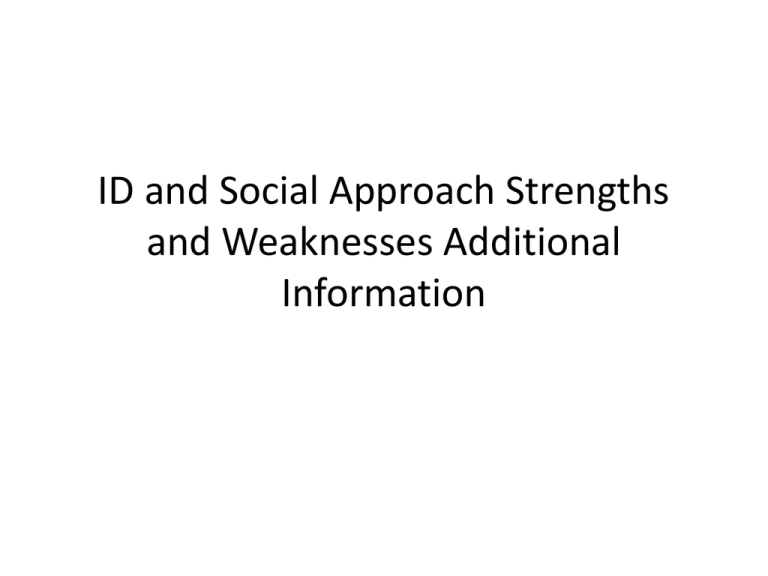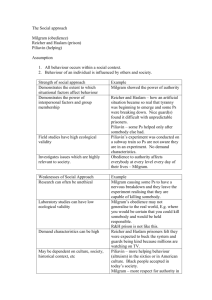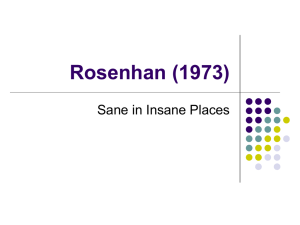ID and Social Approach Strengths and Weaknesses teacher
advertisement

ID and Social Approach Strengths and Weaknesses Additional Information Individual Diffrences Strength Evidence Aims to look at the motivations behind behaviour (what causes people to behave the way they do). E.g. in Griffiths, the ‘thinking aloud’ aimed to see their irrational reasoning, showing how different types of gambler use different heuristics. In T&C they used interviews with Eve and her family to find out about her past and were able to establish a cause for her MPD. These examples show how looking at people as individuals may best show how individual cognitions and experiences can lead to abnormal behaviour later in life. Can be useful in improving the experiences of people with mental health problems – e.g. Thigpen and Cleckley, Rosenhan and Griffiths Rosenhan’s findings contributed to improvements in patient care and an awareness of the pitfalls of using diagnostic criteria, highlighting the need to treat people as individuals. T&C aimed to help Eve and though they did not cure her, did improve some of her symptoms e.g. headaches and blackouts, showing the importance of understanding the unique situation of sufferers and how taking an individual differences approach can benefit patients. High in Ecological Validity – e.g. Rosenhan, Griffiths Rosenhan’s study took place in real hospitals with no demand characteristics. Griffiths took place in a real life arcade, with money to play for. This supports the approach as it shows that Individual Differences in thoughts and behaviour exist in the real world. We can use objective psychometric tests to show the difference between normal and abnormal, and to measure differences between individuals Thigpen and Cleckley used IQ and memory tests to see if there was an objective difference between each of Eve’s personalities. This lends an element of reliability and objectivity to the ID approach. (more of a supplementary point e.g. if you have 2 strengths already and want to add another) As people are all unique the only way we can look at them is to see them as an individual (the idiographic approach) For example MPD is a rare and idiosyncratic disorder – no two people will have it in the same way. Griffiths showed that different people use different heuristics and that the wrong use of these can lead to problems with rationalisation, outlining the contribution of individual differences. Rosenhan showed that using a set of criteria to diagnose mental illness may not be the most valid way to measure the experience of mentally ill people and that they should be treated as individuals. Both of these examples show how treating people and patients as individuals can improve their well being and reduce suffering. Strength Evidence Ignores the influence of the situation affecting behaviour E.g. it ignores the influence of culture as MPD is far more prevalent in the USA, suggesting that there is something about the society in which you live that influences your behaviour/thinking. This suggests that there may be more to behaviour than individual differences. Small samples/case studies leads to problems with generalisability – Eve White was a unique case and cannot, therefore, be generalised beyond her experience of the disorder. Griffiths study had a relatively small sample and therefore it may not be reflective of all regular gamblers. The nature of the ID approach requires in depth and often small samples, this limits its usefulness as it cannot be applied groups of people. Lacking in control over the environment Rosenhan’s study took place in a natural environment (field study) so there was no way of controlling extraneous variables. Eve White had a naturally occurring disorder and again, they could not manipulate the variables. Griffiths too had a naturally occurring IV (though this is an ethical strength) This means that we cannot be certain the individual differences are the only cause of the behaviour. This types of research can create labels as it separates normal from abnormal Rosenhan’s study showed the effects of labelling and perhaps the research into ID that says some people are ‘different’ could lead to negative consequences for the individual. If we are ‘lumping together’ people into ‘sane’ and ‘insane’ then we are no longer looking at them as individuals. Social Strength Evidence Demonstrates the extent to which situational factors affect behaviour Milgram showed the power of authority and the setting in which people are acting. Yale is a prestigious university therefore participants trusted the experimenter and the situation implied a professionalism and competency. This shows how the situation can exert an influence over individuals’ behaviour. Demonstrates the power of interpersonal factors and group membership Reicher and Haslam – showed how identification with a group can have an effect on behaviour e.g. the prisoners became more tyrannical e.g. trying to overthrow the guards. This shows the influence of groups on behaviour. RH – an example of interpersonal influence on behaviour was when they introduced the Trade Unionist – this demonstrated how one person could change the group dynamic. Field studies have high ecological validity Piliavin’s experiment was conducted on a subway train so Ps are not aware they are in an experiment. No demand characteristics. They experimenters found that under certain conditions people were more likely to help. This demonstrated how there is an effect of others/the environment in real life settings. Investigates issues which are highly relevant to society and may explain unexplained phenomena or events Milgram’s study can help to explain atrocities such as the My Lai massacre, as he found that people were obedient to authority and would undergo an agentic shift. This demonstrates how in certain situations the influence of others and the environment may lead to atrocities. Piliavin & Kitty Genovese… Piliavin’s findings about bystander behaviour may help to explain why people may not help in an emergency, for example in the case of Kitty Genovese. This shows how the social approach can help us to understand everyday or even unusual behaviour. Weaknesses of Social Approach Evidence Research can often be Milgram causing some Ps to have a nervous breakdown and they leave the experiment realising that they are capable of killing unethical somebody – this shows that how, sometimes in order to understand group behaviour unethical conduct is required. Laboratory studies can have Milgram’s obedience may not generalise to the real world as his study was conducted in a lab, a far cry from the traumatic and very low ecological validity real situation of war R&H - prisons are not something you go to voluntarily and generally there will be little control in real life over group dynamic. These examples show how some of the assumptions made by the SA are based on ecologically invalid information. May be dependent on culture, Piliavin – more helping behaviour (altruism) in the sixties or in society, historical context, etc American culture. Milgram – more respect for authority in the sixties? This shows that the findings of social approach studies are context and culture dependent and may not be applied now or in all cultures. Ignores the influence of e.g. not everyone went to 450V in Milgram’s study individual differences Piliavin - some people are more willing to help R&H some guards were more authoritarian. This shows how the social approach cannot explain all behaviour, as some people behave differently from what is expected.









